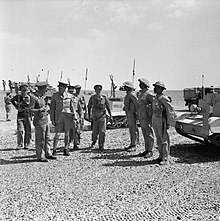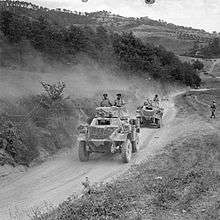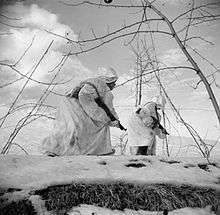10th Indian Infantry Division
The 10th Indian Infantry Division was a war formed infantry division of the Indian Army during World War II. In four years, the division travelled over 4,000 miles (6,400 km) from Tehran to Trieste, fought three small wars, and fought two great campaigns: the Anglo-Iraqi War, the Invasion of Syria-Lebanon, the Anglo-Soviet invasion of Iran, the North African Campaign, and the Italian Campaign.
| 10th Indian Infantry Division | |
|---|---|
 Insignia of the 10th Indian Infantry Division, World War II. | |
| Active | 1941–1947 1947– |
| Country | |
| Allegiance | |
| Branch | |
| Type | Infantry |
| Size | Division |
| Engagements | World War II:
|
| Battle honours | North Africa Italy |
| Commanders | |
| Notable commanders | William Slim Wilfrid Lloyd Denys Reid |
History
World War II
.jpg)


The 10th Indian Infantry Division was formed in January 1941, out of the 20th, 21st and 25th Indian Infantry Brigades. Commanded by Major General William "Bill" Slim, it landed in Basra in April, moving up the Euphrates and capturing Baghdad and the oilfields of Mosul as part of the Anglo-Iraqi War. When Iraq's ally Nazi Germany relocated its aircraft to Vichy French Syria, the 10th invaded Syria from Iraq in June. The 21st Brigade advanced towards Aleppo, while the 20th and 25th Brigades guarded the communication lines and the Mosul oilfield, respectively. Following the French surrender on 11 July, the division returned to guard duty in Mosul. In August, the division took part in the joint Anglo-Soviet invasion of Iran. At the conclusion of the Iranian operation, it returned to Iraq, where it underwent additional training and undertook security duties until May 1942.[1] In March 1942, command of the division passed from Slim to Major General Thomas "Pete" Rees when Slim was ordered to India to take command of Burma Corps, the kernel that would eventually become the British Fourteenth Army.[2]
We had scrambled thought skirmishes of the Iraq rebellion, been bloodied, but not too deeply, against the French in Syria, and enjoyed the unrestrainedly opéra bouffe of the invasion of Persia. We had bought our beer in Haifa and drunk it on the shores of the Caspian. We could move, we could fight, and we had begun to build up that most valuable of all assets a tradition of success. We had a good soldierly conceit of ourselves. Now in March 1942, in spite of dust storms ...it was stimulating to be in what we all felt was a critical spot, waiting for the threatened German invasion of Turkey.
— Slim – Defeat into Victory[3]
The division then moved on to North Africa, reaching Halfaya Pass on 4 June to take part in the Western Desert Campaign.[4] Initially the 10th Indian Infantry Division was committed piecemeal with units involved at El Adem and Sidi Rezegh during the 1942 Battle of Gazala. In June the division, with the 2nd Free French Brigade under command, was ordered by Lieutenant General William Gott, the XIII Corps commander, to hold a position near the Egyptian border with Libya for 72 hours during the British Eighth Army's retreat to El Alamein. Major General Rees responded that the division had only just concentrated and that defensive works were as yet inadequate. He believed, therefore, that the division was unlikely to be able to withstand a full-scale attack from Erwin Rommel. Gott immediately visited Rees and relieved him of command of the division, telling him he lacked resolution.[5] During its retreat from Libya, the division was tasked with defending the coastal town of Mersa Matruh. In the ensuing battle it was overwhelmed and forced to retreat. 60% of the men evaded capture, reaching the Allied lines at El Alamein the following day. Most of the survivors were sent to the Nile Delta to recover. However, part of the division formed the improvised Robcol formation (comprising a regiment each of field artillery and light anti-aircraft artillery and a company of infantry), which held the Ruweisat Ridge between 2–3 July during the First Battle of El Alamein.[4]
In August, command passed to Major General Alan Bruce Blaxland while the division was sent to Cyprus with the responsibility of protecting the island. In July 1943, Major General Wilfrid Lewis Lloyd took command. In August, the 10th had relocated to the Middle East, now incorporating the 1st Greek Brigade, composed of royalist Greek and Yugoslavian troops along with the 20th and 25th Indian Brigades. During the summer it underwent training for a planned invasion of Rhodes, but the Allied defeat in the Dodecanese campaign put an end to those plans. In November it was placed on security duty in Lebanon. On 27 November, it began training for amphibious assault and mountain warfare in preparation for its role in the Italian Campaign.[6] In January 1944, Lloyd was killed in a car accident while overseeing a training exercise in Egypt; command passed to Major General Denys Whitehorn Reid.[7]

On 9 March 1944, the division was ordered to transfer to the Italian front. On 22 April, it relieved the 1st Canadian Division at the Ortona sector, which it held along with the 4th Indian Infantry Division. There it engaged in frequent patrols to prevent the enemy from sending reinforcement to the ongoing Battle of Monte Cassino. On 4 June, the division was moved to Venafro where it continued its training in mountain and urban warfare. The division returned to the front lines on 28 June, replacing the 8th Indian Infantry Division. Advancing through the Tiber valley, the division occupied Umbertide on 2 July. Taking advantage of its training in mountain warfare, it went on to take Città di Castello and Montone, infiltrating deep into Axis positions and striking from the flanks and the rear. By 1 August, the division's vanguard had reached the north of the Tiber river's basin. Further advance was blocked by the Alpe di Catenaia heights, a solid block of ridges and peaks that could only be taken by a set piece assault. On 4 August, troops belonging to the 10th Division captured Monte Altuccia; two days later the Regina height was occupied. It was abandoned as the division had to replace the 4th Indian Infantry Division on its former front line sector which spanned 15 miles (24 km). On 19 August, the Alpe di Catenaia heights were finally overtaken by the 3/1st Punjabis. On 17 September, the unit was transferred to the Adriatic in an effort to penetrate the Gothic Line.[8]
Numerous mountain battles and river crossings followed with Operation Olive on the Gothic Line and then Operation Grapeshot. The 10th Indian Infantry Division earned many battle honours and decorations and suffered many casualties before final victory in Italy and the end of World War II in Europe in May 1945. Security tasks on the Yugoslav border around Trieste completed the 10th Indian Division's war service.
Order of battle
1941
Prior to its piecemeal dispatch to Iraq, April 1941[9]
- 20th Indian Infantry Brigade
- 2nd Battalion, 8th Gurkha Rifles
- 2nd Battalion, 7th Duke of Edinburgh's Own Gurkha Rifles
- 3rd Battalion, 11th Sikh Regiment
- 21st Indian Infantry Brigade
- 2nd Battalion, 10th Gurkha Rifles
- 2nd Battalion, 4th Gurkha Rifles
- 4th Battalion, 13th Frontier Force Rifles
- 24th Indian Infantry Brigade
- 2nd Battalion, 6th Rajputana Rifles
- The Kumaon Rifles
- 5th Battalion, 5th Mahratta Light Infantry
- 25th Indian Infantry Brigade
- 1st Battalion, 5th Mahratta Light Infantry
- 2nd Battalion, 11th Sikh Regiment
- 3rd Battalion, 9th Jat Regiment
- Division Troops
- Royal Artillery
- 3rd Field Regiment
- 157th Field Regiment
- Indian Engineers
- 9th and 61st Field Companies Queen Victoria's Own Madras Sappers and Miners
- 41st Field Park Company Queen Victoria's Own Madras Sappers and Miners
1944
Italy, March 1944 – June 1945[10]
- 10th Indian Infantry Brigade
- 1st Battalion, 2nd Punjab Regiment (until 29 August 1944)
- 1st Battalion, Durham Light Infantry (from May 1944)
- 4th Battalion, 10th Baluch Regiment
- 2nd Battalion, 4th Prince of Wales's Own Gurkha Rifles
- 20th Indian Infantry Brigade
- 8th Battalion, Manchester Regiment (until Oct 1944)
- 1st Battalion, 2nd Punjab Regiment (from Oct 1944 to May 1945)
- 2nd Battalion, Loyal Regiment (North Lancashire) (from May 1945)
- 3rd Battalion, 5th Mahratta Light Infantry
- 2nd Battalion, 3rd Queen Alexandra's Own Gurkha Rifles
- 25th Indian Infantry Brigade
- 1st Battalion, King's Own Royal Regiment (Lancaster)
- 3rd Battalion, 1st Punjab Regiment
- 3rd Battalion, 18th Royal Garhwal Rifles
- 4th Battalion, 11th Sikh Regiment (from January 1945)
- Division troops
- 1st Duke of York's Own Skinner's Horse (Divisional Reconnaissance Regiment)
- 10th Indian Division Signals
- 1st Battalion, Royal Northumberland Fusiliers (Machine Gun Battalion)
- Royal Artillery
- 68th (South Midland) Field Regiment, Royal Artillery
- 97th (Kent Yeomanry) Field Regiment, Royal Artillery
- 154th (Leicestershire Yeomanry) Field Regiment, Royal Artillery
- 13th Anti-Tank Regiment, Royal Artillery
- 30th Light A.A. Regiment, Royal Artillery (left November 1944)
- Indian Engineers
- 5th Field Company King George's Own Bengal Sappers and Miners
- 10th and 61st Field Companies Queen Victoria's Own Madras Sappers and Miners
- 41st Field Park Company King George's Own Bengal Sappers and Miners
- Support Units
- Royal Indian Army Service Corps
- 10th Indian Division Troops Transport Company
- 10th, 20th and 25th Brigade Transport Companies
- 27th Animal Transport Company (Mule)
- Indian Army Medical Corps
- 14th, 21st and 30th Indian Field Ambulances
- 12th Indian Field Hygiene Section
- Corps of Military Police (India)
- 10th Indian Division Provost Unit
- Indian Army Ordnance Corps
- 10th Indian Division Ordnance Field Park
- Indian Electrical and Mechanical Engineers (IEME)
- 125th, 126th and 127th Infantry Workshop Companies
- 10th Indian Division Recovery Company
- Indian General Service Corps
- 10th Indian Divisional Field Post Office
- 53rd Indian Field Post Office
- Intelligence Corps (India)
- 5th and 407th Indian Field Security Sections
- Royal Indian Army Service Corps
Assigned brigades
In addition to those listed above the following brigades were assigned or attached to the division for relatively short times during World War II.[11]
- 1st Armoured Brigade (1–5 June 1942)
- 2nd Indian Armoured Brigade (Aug–Dec 1942)
- 7th Armoured Brigade (Nov 1944 – Jan 1945)
- 9th Armoured Brigade (Sept 1941)
- 252nd Indian Armoured Brigade (Jan 1942)
- 1st Guards Brigade (2–5 June 1942)
- 5th Indian Infantry Brigade (Jun–Jul 1942)
- 15th Indian Infantry Brigade (Feb–Mar 1941)
- 17th Indian Infantry Brigade (Jul–Aug 1941)
- 18th Indian Infantry Brigade (Jun 1942)
- 43rd (Lorried) Indian Infantry Brigade (Oct–Dec 1944)
- 234th Infantry Brigade (Aug–Sept 1943)
General Officers Commanding
From[12]
- Major-General W.A.K. Fraser (January 1941 to May 1941)
- Major-General William Slim (May 1941 to March 1942)
- Major-General T.W. Rees (March 1942 to June 1942)
- Major-General J.S. Nichols (June 1942 to July 1942)
- Major-General A.B. Blaxland (July 1942 to July 1943)
- Major-General W.L. Lloyd (July 1943 to January 1944)
- Major-General D.W. Reid (January 1944 to end of war)
Notes
- Kavanagh 2014, pp. 47–48.
- Slim William. Defeat into Victory p. 19
- Slim William. Defeat into Victory p. 3
- Kavanagh 2014, p. 48.
- Mead (2007), p. 373
- Kavanagh 2014, pp. 48–51.
- Kavanagh 2014, p. 57.
- Kavanagh 2014, pp. 60–70.
- "10th Indian Division 15/04/1941". Orders of Battle. Archived from the original on 8 March 2016. Retrieved 7 December 2015.
- Palmer, Rob. "10 Indian Division (1944–1945)". British Military History. Retrieved 6 December 2015.
- "10 Indian Infantry Division Subordinate units". Orders of Battle. Retrieved 7 December 2015.
- "10 Indian Infantry Division Appointments". Orders of Battle. Retrieved 7 December 2015.
Sources
- Kavanagh, Matthew David (2014). The 10th Indian Division in the Italian Campaign, 1944–45: Training, Manpower and the Soldier's Experience (PDF) (MA). no ISBN ID Code 5632. Birmingham University: School of History and Cultures College of Arts and Law. Retrieved 29 June 2016.CS1 maint: ref=harv (link)
- Mason, Philip (1982). The Indian Divisions Memorial, 1939–1945, Royal Military Academy Sandhurst. Wellingborough: Skelton's Press. OCLC 476422080.
- Orgill, Douglas (1967). The Gothic Line: The Autumn Campaign in Italy. London: Heinemann. OCLC 956232.